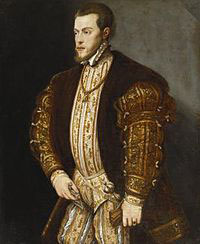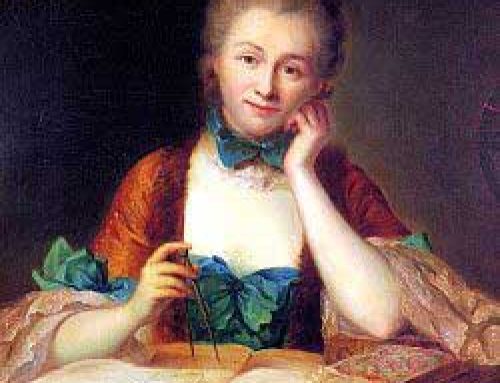
Philip II of Spain
Philip II of Spain
As the great-grandson of Isabella, who had sent Columbus to America, and the son of Isabella of Portugal, Philip II ruled Spain starting in 1556 AD.
Isabella and Ferdinand
Isabella of Portugal
All our modern Europe articles
Philip also controlled huge Spanish territories in South and Central America, Mexico, Arizona, New Mexico, California, Nevada, Utah, Colorado and Texas.
Mexico and colonization
The Pueblo Revolt
The Apache in Texas
Californians
The Utes
Philip also ruled the Netherlands and Flanders (now part of Belgium), north of France. As if that wasn’t enough, Philip’s cousin ruled Austria, Hungary, and a lot of Italy as the Holy Roman Emperor.
Austria-Hungary in the 1500s
Spain: the world’s most powerful empire.
Philip’s empire was the most powerful empire in the world. Spanish ships carried European salt, steel, glass beads, and paper to West Africa, where they sold those things and bought enslaved people and gold. Then they sold those slaves in Brazil and Peru and picked up silver, sugar, coffee, and pearls.
History of silver
African-American slavery
Traders brought the silver to China and sold it for porcelain and silk, or in India for cotton cloth and pepper, and sold the porcelain and silk, cotton, pepper, coffee, sugar and pearls back in Europe.
Chinese porcelain
Indian cotton cloth
The Spanish got richer and richer, as the Arabian Peninsula, Central Asia, and India became poorer.
Spain defeats the Ottoman Empire
Philip II spent a lot of time worrying about how to keep his empire powerful. The Ottoman Empire had been growing very quickly, and people thought Suleiman might conquer all of Europe, as the Romans once had. Philip’s cousin had to pay tribute to Suleiman to keep the Ottoman army from invading Austria.
The Ottoman Empire
In 1566, Suleiman died, and then in 1571, Spain and Venice destroyed the Ottoman navy at the Battle of Lepanto. Philip’s navy could afford a lot more guns than the Ottomans. After that Spain was safe from the Ottomans.

Battle of Lepanto in 1571
But then silver becomes less valuable
But Spain still had big problems. Spanish ships had brought tons of silver to Europe from South America. China needed silver to make coins with, so they were willing to pay very high prices for silver. Spanish traders were able to buy a lot of Silk Road stuff with their silver.
Why did China need so much silver?
The Ming Dynasty in China
At first the rich families of Spain got super rich. They bought all sorts of fancy stuff like silk and porcelain from China. They also bought a lot of wool cloth and other things from England, and that made England much richer too.
But then Silk Road traders realized that silver wasn’t so rare anymore, and they weren’t willing to pay such high prices for it. silver got less valuable. Philip had spent a lot of money on his wars, thinking he would make big profits on the silver. Without those big profits, he couldn’t pay his debts.

Mariana of Austria, Queen of Spain (by Velazquez, ca. 1652)
England defeats the Spanish Armada
Also, Philip had been able to do whatever he wanted in Europe without worrying about England or France. Catherine de’ Medici in France and Mary and Elizabeth in England were busy with civil wars between Catholics and Protestants.
But in 1588, only three years after Philip defeated the Ottomans, Queen Elizabeth of England defeated the Spanish Armada, and the next year Henry IV became king of France.
Philip realized he had to fight inside Europe as well as outside it. By spending Spanish silver on their ships, the British navy was getting to be stronger than the Spanish navy. British pirates attacked Spanish ships and took their pearls and silver. Many ships left Britain for West Africa, sailed from there to America, and then back to Britain in the “Triangle trade” without going to Spain. Spain didn’t have enough cloth and iron tools to sell.
Philip III, Philip IV, and Mariana
When Philip II died of cancer in 1598, his son Philip III took over, and after him his son, Philip IV (whose sister Anne of Austria married Louis XIII of France). Starting in 1618, Spain fought in the Thirty Years War in Europe.
The Thirty Years’ War
Anne of Austria
After Philip IV died in 1665 AD, his wife Mariana of Austria ruled Spain as regent for their four year old son, Charles II, just as her cousin Anne of Austria had recently ruled France for her four year old son, Louis XIV. Mariana’s brother Leopold was the Holy Roman Emperor.
Because Charles was disabled, his mother Mariana ruled pretty much for the rest of her life, until she died of breast cancer in 1696. But she didn’t do as well as Anne of Austria had in France: Portugal became independent, taking Brazil with it, the Pueblo Revolt got the Pueblo people their independence and brought horses to many Native Americans, and Louis XIV of France took control of more and more of the Netherlands.
War of the Spanish Succession
When Charles died in 1700 AD, at 39 years old, he left no sons. He was the last of the Hapsburg family to rule Spain. After Charles II died all the European countries fought the War of the Spanish Succession to see who would rule next.
War of the Spanish Succession
By this time, Britain had taken over most of the trading that the Spanish had done before, and it was Britain that was getting rich.
